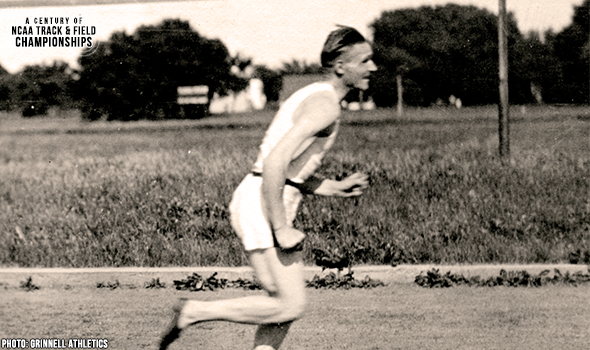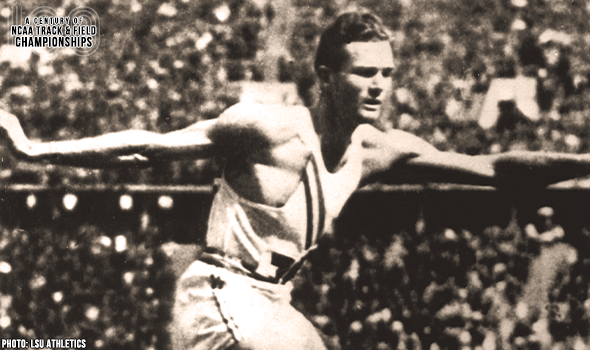
Gordy Played Hero, Sent LSU To Team Title
“A team that possesses an unknown boy who can turn in a ‘pressure’ stunt like that deserves to win a team championship.” ~ Maxwell Stiles, Los Angeles Times
The team title at the 1933 NCAA Track & Field Championships in Chicago turned into a thrilling battle between programs at opposite ends of experience in the meet.
Nowhere was that more evident than in the concluding event, the pole vault.
Southern California was then in its early days of dominating the NCAA Championships (The Trojans were seeking a fourth team crown in eight years) and had the favorite in the event – world-record holder Bill Graber. His lofty personal-best of 14-4⅜ (4.37m) was more than six inches ahead of his then-meet-record standard of 13-10¼ (4.22m) set two years prior where he was crowned co-champion.
LSU was making its first appearance at the NCAA Championships and entered little-known Matt Gordy, who had a best of 13-4 (4.06m). A month earlier, he was part of a three-way tie to win the inaugural Southeastern Conference meet.
Teamwise, LSU surprisingly led USC 49-45 going into the pole vault. However, the Trojans had a path to team victory that lost a major obstacle when the four vaulters who cleared 13-6 (4.11m) did not include Stanford’s William Miller, the reigning Olympic gold medalist.
With Graber’s most-feared threat out of the competition, most felt if anyone could challenge him it would be one of the Midwest pair of Ernest Lennington (Illinois) and John Wonsowicz (Ohio State), both of whose 13-6 clearance matched their best from 1932 when they were among a six-way tie for second.
No one gave Gordy much chance, as his 13-6 clearance was not only a PR but also matched the best he’d ever done in practice.
With the bar raised to the meet-record height of just over 13-11 (4.24m) – PR territory for all but Graber – the USC senior sailed over on his second attempt. Only Gordy remained after Lennington and Wonsowicz missed their third attempts.
The team crown was also in the balance: A clearance by the Tiger senior meant Gordy and Graber would tie and LSU would win 58-54, while a miss would give Gordy a share of second and LSU would tie USC with 55 points each.
Gordy nudged the bar, but got over, bringing many fans to swarm the co-champion in celebration. As officials did not raise the bar any higher, the event and meet were over, giving the Tigers the team title that many consider one of the meet’s biggest upsets.
“A team that possesses an unknown boy who can turn in a ‘pressure’ stunt like that deserves to win a team championship,” wrote Maxwell Stiles of the Los Angeles Times.
The NCAA and collegiate track & field will mark a momentous milestone in the spring of 2021 -- the 100th anniversary of the NCAA Championships and with that, the NCAA Track & Field Championships. In June 1921, the University of Chicago hosted the first track & field championships in NCAA history.
This point can’t be emphasized enough: Not only was the event the first for NCAA track & field, but the first championships for any sport under the sponsorship of the NCAA.
To celebrate, over each of the next 365 days, the U.S. Track & Field and Cross Country Coaches Association (USTFCCCA) will celebrate moments, student-athletes, and coaches that have made a century’s worth of championships special. From humble beginnings to important historical milestones to the modern-day, collegiate track & field has evolved with the American society.
The 2021 edition of the NCAA Division I Outdoor Track & Field Championships begin with preliminary round action on May 27-29 in Jacksonville, Fla., and College Station, Texas. The championships final site and culmination of the celebration is slated for June 9-12, 2021 at the newly rebuilt Hayward Field in Eugene, Ore.

SIU’s Roggy Dominated The Javelin In 1978
Bob Roggy won the javelin title at the 1978 NCAA DI Outdoor T&F Championships by more than 20 feet. Roggy qualified first for the final with a MR heave of 89.30m (293‑0).

Makusha Made History In Bowerman Year Of 2011
Ngoni Makusha became just the fourth man in meet history to win individual titles in both the 100 and LJ. It was his 3rd career LJ crown and he set a CR in the 100 of 9.89.

George Mason’s Gage Shocked The NCAA LJ In 1988
Nena Gage won the long jump at the 1988 NCAA DI Outdoor T&F Championships in a shocking upset over Gail Devers.

Texas’ Thompson Marveled In NCAA Distance Events
Jerry Thompson won three career distance titles at the NCAA Outdoor T&F Championships. His first came in 1943. Then he won again in 1947 & 1948 after serving in World War II.

Grinnell’s Paulu Sprinted To NCAA History
Leonard Paulu was the first athlete to complete the 100-200 double in NCAA Outdoor Track & Field Championships history in 1922. That also made him the 1st to win back-to-back 100 titles, too.

Scott Won Back-To-Back NCAA Hammer Titles
Candice Scott won back-to-back hammer throw titles at the NCAA DI Outdoor T&F Championships in 2003 & 2004. Scott set a meet record of 69.77m (228-11) in that first year.

Drouin Soared To The Bowerman In 2013
Derek Drouin won two career HJ titles at the NCAA DI Outdoor T&F Championships. When Drouin won in 2013, he was only the fourth man to clear 2.34m (7-8) in meet history.

Watts Made Quick Work Of NCAA 400
Quincy Watts set a meet record in the 400 of 44.00 at the 1992 NCAA DI Outdoor Track & Field Championships. It lasted 25 years until 2017.

Iowa State’s Koll Rolled To 5K-10K Crowns
Lisa Koll won three career titles at the NCAA DI Outdoor T&F Championships in dominant fashion. Her average margin of victory in those 5K & 10K races was 37.73 seconds.

LSU’s Hardin Completed Unique 440-220H Double Twice
The nearly unheard of 440-220H double was so nice that Glenn Hardin did it twice! Hardin became the first to do so in meet history in 1933 and then swept them again in 1934.

